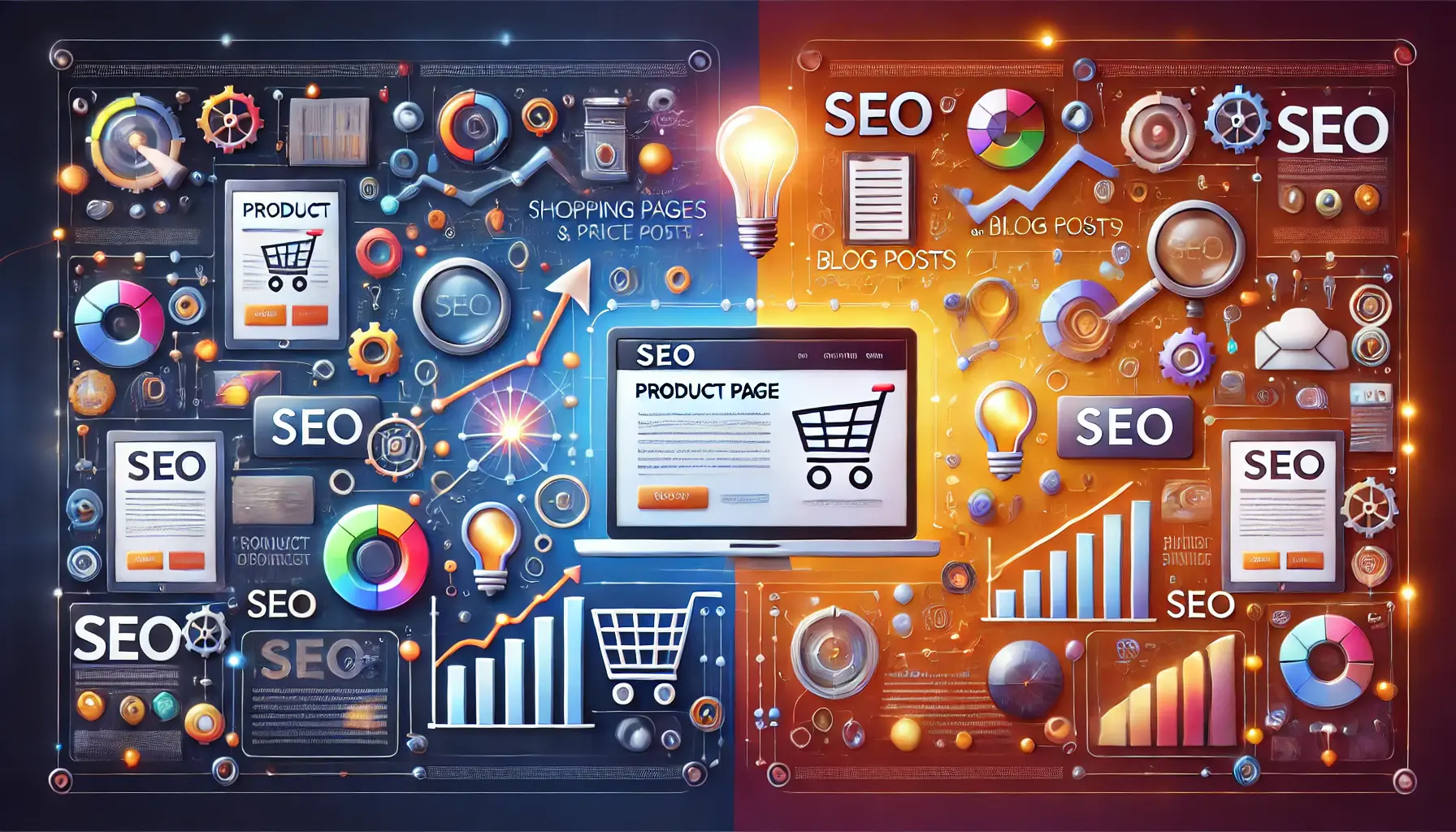If you are looking to open an online store, that simply isn’t good enough in the digital landscape of today.
Opening an online store is just the first step. You must optimize your product pages for SEO and conversions to thrive in the competitive digital space.
- Product Pages Must Be SEO-Optimized and Convert
- Why SEO is a Big Deal for Product Pages
- The Relevance of SEO to Product Page Success
- The Ultimate Guide to SEO for Product Pages vs Blog Posts
- High-Converting Product Pages Keyword Research
- How to Write Compelling Product Page Content That Ranks
- On-Page SEO Techniques for Product Pages
- Product Pages and the Technical SEO Angle
- Enter the SEO Framework for Product Pages: A Rundown
- Common Questions Regarding Product Page SEO
Product Pages Must Be SEO-Optimized and Convert
Really, how often have you ever gone to a stunningly designed product page and then clicked away because it just took too long to load (or didn’t answer your questions…
or didn’t rank well on search pages)?
This is where optimization for product pages is important.
Not only does it help in ranking your product pages higher, but also ensures that the design of the page itself helps convert users into customers.
This post breaks down everything you need to know about SEO for product pages, from keyword research to creating relevant content that satisfies both your users and search engines.
Let’s get started!

An illustration showcasing how SEO boosts visibility and traffic for product pages.
Why SEO is a Big Deal for Product Pages
The importance of SEO for product pages is immense.
Properly executed SEO increases your product page visibility and drives targeted traffic to your website.
The right SEO can actually connect your products with the buyers who are actively searching for them.
So, what makes SEO the game-changer for product pages?
SEO helps you attract the right audience, drive qualified traffic, and increase your product page’s chances of success through visibility and conversions.
- Visibility and Traffic: Better SEO will have your product pages higher up the search rankings, making you more likely to be found by people ready to buy. Think of it as putting your product on the front shelves—more people will reach for it.
- Conversions: The traffic generated by organic searches means attracting leads who are already interested, leading to higher conversion rates compared to other sources.
- Targeted Keywords: The best way to attract buyers who are ready to make a purchase is by targeting the right keywords and ensuring perfect content optimization on your product pages.
- Brand Trust & Authority: Searchers trust pages that frequently appear at the top of their search results. If your product pages consistently rank on the first page, it reinforces your brand’s authority as a front runner in the industry.
- Long-Term Success: While paid ads might deliver quicker results, they are short-lived. In contrast, SEO efforts often provide long-lasting results, continuing to bring traffic and conversions long after the work is done.

An illustration emphasizing the connection between SEO and product page success, featuring key indicators of optimization and success.
The Relevance of SEO to Product Page Success
SEO isn’t just about driving traffic; it’s about attracting the right kind of traffic.
You want to bring in visitors who are actively searching for your product, not just any random clicks.
This means choosing keywords that are highly relevant to your product pages and ensuring that the entire page is geared toward solving your potential buyers’ problems.
By ranking highly in organic search results, your product pages will naturally draw more qualified visitors, making SEO a far better method than simply buying traffic through ads.
Additionally, the higher you rank in search results, the further ahead you place yourself against your competitors in the industry.

An image showcasing the differences in SEO strategies for product pages versus blog posts.
The Ultimate Guide to SEO for Product Pages vs Blog Posts
Product pages require a different SEO strategy than blog posts.
While blog posts are focused on providing valuable information, product pages should be focused on driving conversions.
So, how do the SEO strategies differ between product pages and blog posts?
- Intent: Blog posts are often informational, while product pages have a commercial nature with a strong purchase intent.
- Keyword Focus: Product pages need to focus on keywords that are closely tied to purchase intent, whereas blog posts might focus on more informational or educational keywords.
- Content Type: Product pages should focus on the product itself—its benefits, features, and pricing. On the other hand, blog posts can provide more in-depth discussions on related topics that support the customer’s decision-making process.
- Call-to-Action (CTA): A product page typically encourages users to make a purchase, while a blog post might guide readers toward further engagement or additional content.
Understanding these differences will dramatically improve your ability to optimize product pages in a way that drives both traffic and conversions.
Recognizing the different SEO strategies for product pages versus blog posts is crucial for ensuring the right kind of traffic that converts into sales.

An illustration representing the significance of keyword research for optimizing high-converting product pages.
High-Converting Product Pages Keyword Research
One of the most important elements to getting product pages optimized for SEO properly is effective keyword research.
Without it, your product pages will never be seen by the right kind of buyers—regardless of how well-designed or how exceptional the products may be.
Keyword research is not just about discovering the most popular search terms but also understanding what your potential audience is searching for and how they phrase those searches.
By targeting the correct keyphrases, you can ensure your product pages are discovered by people more inclined to become customers.

An illustration highlighting the process of finding effective keywords for product pages using digital tools.
How to Find Keywords for Product Pages
Start with the product pages themselves—when doing keyword research for your product pages, make sure you include keywords that not only describe your products but also suggest purchase intent.
For example, someone searching for ‘best smartphone’ may still be in the research phase, whereas a search for ‘buy iPhone 14 Pro Max’ indicates a user closer to making a purchase.
These are the exact keywords you should target on your product pages.
- Purchase Intent: Determine keywords with a high likelihood of purchase, such as ‘buy,’ ‘order,’ or ‘for sale.’
- Use Long-Tail Keywords: Include long-tail keywords directly related to your products, which typically have lower competition and higher conversion rates.
- Product-Specific Keywords: Use keywords specifically related to your product, such as model numbers, colors, and sizes. These keywords help connect your product pages with shoppers further down the buying funnel, ready to take action.

An illustration demonstrating the effectiveness of long-tail keywords in driving conversions.
Long-Tail Keywords and Conversion
While many marketers focus on higher-volume, broader search terms, long-tail keywordsLong-tail keywords are more specific, longer search terms that usually have lower search volume but higher conversion rates. can be incredibly powerful for product pages.
These longer, more specific keywords might have lower search volumes, but they indicate higher intent.
For example, instead of optimizing for ‘running shoes,’ consider focusing on a long-tail keyword like ‘best running shoes for flat feet.’
What makes long-tail keywords so valuable?
They tend to drive highly relevant traffic.
Customers searching for these specific terms already know what they want, and they are more likely to convert when they find exactly what they’re looking for on your product page.

An illustration representing the balance between search volume and user intent in optimizing product pages.
How to Balance Search Volume and Intent for Product Pages
One of the biggest challenges in optimizing product pages is finding the right balance between search volume and user intent.
High-volume keywords can drive more traffic, but if the intent behind them doesn’t align with what you are selling, that traffic may not convert.
Meanwhile, low-volume keywords may bring less traffic, but the conversion rates are typically much higher because these visitors have a stronger intent to buy.
Your strategy should be a combination of both high-volume and low-volume keywords.
Start by targeting broad keywords in your main headings and subheadings, then narrow your focus to specific, intent-driven keywords in your product descriptions and meta tagsMeta tags provide metadata about your website to search engines and visitors, often helping to improve SEO..

An illustration showcasing the use of effective keyword research tools for optimizing product pages.
Effective Keyword Research Tools for Product Pages
Here are some of the best tools you can use to enhance the keyword rankings of your product pages.
Tools like Google Keyword Planner, Ahrefs, SEMrush, and Ubersuggest allow you to check search volumes for different terms, identify long-tail keywords, and discover related keywords you might not have considered before.
These tools help you quickly identify what your audience is searching for and how best to align your product pages with those searches.
Remember to continuously monitor your keyword performance and adjust your strategy as needed to ensure your product pages continue to rank highly and convert effectively.

An illustration depicting the creation of engaging product page content that ranks well in search engines.
How to Write Compelling Product Page Content That Ranks
Creating product pages that capitalize on the best-fit keywords is key to success.
Remember, SEO is not just about sprinkling keywords throughout the page.
Your content must also be engaging and educational — aimed at funneling visitors so that they turn into customers.
The most important factor for product page optimization is writing content that appeals to search engines as well as human readers.

An illustration showing the balance of writing search engine-friendly and user-friendly product titles for better SEO and engagement.
How to Write Search Engine-Friendly and User-Friendly Product Titles
The first thing on your product page is the most important element of all — the product title.
This should succinctly describe the product while being peppered with all-important keywords for SEO.
Make sure that the title is readable for users and meaningful to search engines.
An example of a highly optimized title for a product page could be: ‘Lightweight, Comfortable, and Stylish Nike Air Max 2024 Running Shoes.’ The product title not only covers a crucial part of the keyword query, but also highlights what makes this product stand out, making it easier for potential customers to engage.
- Placement of Primary Keywords: Start your product title with the most compelling keywords, such as ‘buy Nike Air Max running shoes.’
- Title Structure: Include key features or benefits of the product in the title, like ‘lightweight’ or ‘comfortable.’
- User-Friendly Title: Ensure the title is short, easy to understand, and SEO-optimized to appeal to both users and search engines.

An illustration depicting the importance of crafting SEO-friendly product descriptions for better rankings and user engagement.
SEO-Friendly Product Descriptions
Use your keywords strategically in product descriptions, ensuring the content is both informative and optimized.
Instead of stuffing a description with keywords, organically weave them into sentences that highlight your product.
For example, instead of simply stating, ‘This running shoe is great,’ you can say something like, ‘The Nike Air Max 2024 Running Shoes are perfect for long-distance runners seeking both performance and style.’ This sentence naturally incorporates keywords like ‘Nike Air Max running shoes’ while providing valuable information.
- Focus on Benefits: Clearly explain how the product will solve the customer’s problem or meet their needs, using relevant keywords like ‘buy running shoes’ or ‘best running shoes for long-distance runners.’
- Incorporate Keywords Naturally: Avoid keyword stuffing. Instead, weave primary and secondary keywords seamlessly into your product descriptions.
- Highlight Unique Selling Points: Focus on what makes your product unique in the market, emphasizing key phrases like ‘lightweight running shoes’ or ‘high-performance running shoes.’

An illustration showing how user-generated content like reviews and Q&A contributes to SEO improvement and engagement.
How User-Generated Content Helps in SEO (Reviews, Q&A)
To effectively boost the SEO of your product pages, encourage user-generated content like reviews and Q&A sections.
User-generated content is fresh, relevant, and valuable for both search engines and potential buyers.
Ask customers to leave reviews and answer questions about the product.
This not only enhances the page’s relevance but also builds trust with potential customers.
Additionally, having a FAQ section allows you to address common questions and naturally include more keywords.
- Get Reviews: Encourage repeat clients to write reviews on your product pages, using keywords like ‘Nike Air Max reviews’ or ‘running shoe feedback.’
- Q&A Sections: Include a section for questions and answers to cover frequently asked questions, incorporating keywords like ‘best running shoes for flat feet’ or ‘lightweight running shoes FAQs.’
- Content Freshness: Regularly update your reviews and Q&A sections to keep the content fresh and relevant for both users and search engines, ensuring your product pages rank higher over time.

An illustration representing effective on-page SEO techniques for optimizing product pages.
On-Page SEO Techniques for Product Pages
If this is the first time you are checking out our SEO series, you might want to begin by exploring the On-Page SEO Techniques for Product Pages.
Once all the content is written and published on your product page, it’s time to go a step further by optimizing it with efficient on-page SEO tactics.
These strategies will ensure that your product pages rank better in web searches, attracting an increasing number of potential customers.
On-page SEO includes multiple factors — from meta tags to internal linking tactics — all of which contribute towards optimizing your product pages for search engines and improving their visibility.

An illustration showcasing the importance of optimizing URLs and meta tags for better search engine rankings on product pages.
URL Optimization & Meta Tags for Your Product Pages
Optimizing meta tags and URLs makes it easy for search engines to understand what your product pages are about, largely due to the help of meta tags and SEO-friendly URLs.
Example: Your main keywords should be included in the meta title and meta description to make the content more attractive.
For instance, an optimized meta title could read: ‘Buy Nike Air Max 2024 Running Shoes | Lightweight & Stylish.’
The meta description might be: ‘Introducing the Nike Air Max 2024—The ultimate fusion of comfort, style, and speed for long-distance running.’
- Title Tag: Use the primary keyword in the title tag before adding a unique selling point (e.g., ‘Buy Nike Air Max 2024 Running Shoes’).
- Meta Description: Naturally incorporate keywords while providing enticing descriptions that make users want to click.
- SEO-Friendly URLs: Short, descriptive URLs with relevant keywords such as ‘nike-air-max-2024-running-shoes’ will improve your rankings.

An illustration showcasing the strategy of building product page authority through internal linking.
How to Create Product Page Authority Through Internal Link Building
Internal linking is a powerful strategy to boost the SEO of your product pages.
By linking related merchandise or content within your website, you can help search engines better understand your site’s structure while improving page authority.
Example: You could link your product pages to blog posts using anchor text like ‘best running shoes for long-distance runners.’
- Link to Related Products: Internal linking within your product pages should direct users towards similar or complementary items.
- Optimizing Anchor Text: Use keyword-rich anchor text in your internal links, such as ‘Buy Nike Air Max Running Shoes.’
- Link to Relevant Blog Content: Ensure your product pages link to blog posts or informational content that users can explore to increase engagement and improve rankings.

An illustration showing the importance of using schema markup to enhance product page visibility through structured data.
Use Schema Markup on Product Pages
Schema markup is structured data that allows search engines to show extra information about your product instantly in the search results—such as prices, stock levels, and review ratings.
By implementing schema markupSchema markup is a type of structured data used to help search engines understand the content of your website and present it in a rich format., you give your product pages better visibility and a higher CTR by helping users see relevant information at a glance.
Example: Adding schema markup to your product page for the ‘Nike Air Max 2024 Running Shoes’ could display the price, availability, and average customer rating directly in the SERPs.
- Product Schema: Every product page should feature structured data for elements such as price, availability, and reviews.
- Rich Snippets: Monitor rich snippets to ensure your schema is properly implemented and displayed correctly in search results.
- Maintain Data Up to Date: Ensure your schema data reflects the most current information about your products, such as updated prices or availability statuses.

An illustration depicting the importance of mobile optimization for product page SEO success.
Product Page SEO for Mobile
In today’s mobile-first world, having product pages optimized for mobile devices is essential for SEO success.
Mobile optimization for product pages can significantly improve your rankings and conversions by providing a better user experience for mobile shoppers.
Using responsive design, compressing images for fast loading times, and ensuring that links and buttons remain clickable on smaller screens are all crucial factors.
- Responsive Design: Keep your product pages responsive across all types of devices and screen sizes for optimal user experience.
- Fast Loading Times: Compress images and optimize code to ensure quick load times on mobile devices, which is essential for both SEO and user satisfaction.
- Responsive Navigation: Ensure that all buttons, links, and menus remain functional and easy to use on mobile devices.

An illustration highlighting the technical SEO aspects of optimizing product pages for better performance and search engine visibility.
Product Pages and the Technical SEO Angle
To keep your product pages visible, fast-loading, and search-engine-friendly, technical SEO is essential.
Although content and on-page SEO are important, overlooking the technical aspects of your product pages when it comes to ranking in Google can seriously affect their performance.
Focusing on these technical SEO elements will ensure that your product pages are indexed properly, load quickly, and provide a positive user experience.

An illustration representing the impact of speed on SEO for product pages, highlighting the importance of fast loading times for better rankings.
Speed and SEO of a Product Page
Product pages, especially those with high-quality content, are critical to Google ranking and page load times.
Pages need to load quickly because even the slightest delay can result in higher bounce rates and reduced conversions.
Slow-loading product pages also negatively impact your SEO ranking since search engines prioritize faster pages.
- Optimize Images: Compress images to reduce their file size without compromising quality. Smaller image sizes will improve page load times and enhance your product pages’ performance.
- Optimize Code: Minify and compress your CSS, JavaScript, and HTML files to further reduce page load times.
- Enable Browser Caching: Cache static resources in the visitor’s browser and set up server-side caching (expires header) to provide returning visitors with faster load times on your product pages.

An illustration representing the process of identifying and resolving duplicate content issues on product pages.
Tackling Duplicate Content on Product Pages
eCommerce sites are particularly prone to duplicate content, especially when it comes to product pages.
Duplicate product descriptions across different pages can confuse search engines, making it difficult for them to determine which page should be prioritized, ultimately causing your rankings to drop.
- Unique Product Descriptions: Write unique descriptions for each product to avoid duplication and improve your SEO performance.
- Canonical Tags: Use canonical tags when you have similar content across different URLs to help search engines understand which version of the page should be prioritized.
- Proper Pagination: Ensure that category and product listing pages have proper pagination implemented to prevent duplicate content issues, especially for large-scale eCommerce sites.

An illustration representing the process of ensuring product pages are correctly indexed and crawled by search engines.
Product Page Indexation and Crawling
To ensure your product pages appear in search results, they must be properly indexed and crawled by search engines.
If search engines can’t find or index your product pages, they will not appear in search results no matter how well-optimized the content is.
- Create an XML Sitemap: Include all your product pages in an XML sitemap to help search engines easily locate and crawl them.
- Use Robots.txt: Ensure that your robots.txt file does not block search engines from crawling important product pages.
- Indexing Check: Regularly review Google Search Console to ensure your product pages are being indexed correctly and are not excluded from search results.

An illustration showing the importance of mastering pagination and category pages for achieving SEO success.
Mastering Pagination and Category Pages for SEO Success
Pagination and category pages are common in eCommerce websites due to product listings, but they can be tricky for SEO.
Managing them correctly ensures that your products are easy to find for both users and search engines.
- Rel=prev/next Tags: Use rel=prev and rel=next tags to help search engines understand the relationship between paginated pages, improving their chances of ranking.
- Optimize Category Pages: Optimize your category pages with the right keywords and unique content, as these pages can rank for broader search terms and drive traffic to your product listings.
- Minimize Pagination: Reduce the number of paginated pages by increasing the number of products displayed on each page. This minimizes the need for excessive pagination and improves user experience.

An illustration showcasing the key elements of an SEO framework for optimizing product pages.
Enter the SEO Framework for Product Pages: A Rundown
Simply stuffing keywords into your content and hoping for the best isn’t optimizing product pages for SEO.
It takes a thoughtful process that includes good keyword research, technical SEO, user experience design, and solid content creation.
Well-optimized product pages can do a lot for your business: increase search traffic, improve positioning in the SERPs, and drive qualified visitors to purchase your products.

An illustration summarizing the key SEO strategies for optimizing product pages effectively.
The Product Page SEO Strategies in Recap
To summarize, here is a breakdown of the most important strategies we have discussed so far for optimizing your product pages:
- Keyword Research: Concentrate on appropriate keywords that align with the search intent of your customers. Use primary and long-tail keywords in your product titles, descriptions, and meta tags to improve product page rankings.
- Creating Conversion-Optimistic Content: Make sure that product pages are filled with interesting, on-topic content that appeals to both users and search engines. Incorporate keywords organically while emphasizing USPs (Unique Selling Points), benefits, and key features.
- On-Page SEO Techniques: Always use on-page SEO techniques such as optimizing meta tags, creating SEO-friendly URLs, and utilizing internal linking strategies. These tactics will help increase your product pages’ discoverability and search engine rankings.
- Internal Linking: Integrate your product pages among related content to boost page authority and improve user engagement. This internal linking also helps search engines understand the structure of your site better.
- Technical SEO Considerations: Pay attention to the technical aspects of your product pages, such as page load speed, addressing duplicate content, and ensuring proper indexing. These elements ensure that your pages are accessible, fast, and prioritized by search engines.
- Mobile Optimization: Google loves mobile-optimized pages, and users prefer shopping on their mobile devices, so ensure your product pages are mobile-friendly. Check that your pages are responsive and load fast on all devices to enhance both SEO rankings and user satisfaction.

An illustration showcasing the vital role of SEO in driving traffic and conversions for product pages.
Why SEO Is Important for Product Pages
SEO for product pages is important because it influences how well your site can receive relevant traffic and convert visitors into customers.
Optimizing your product pages means you are better positioned to be seen by the right audience—customers who use search engines like Google and Bing when they have a strong purchase intent.
Long-term results are also a key benefit of SEO for product pages.
The long-tail of search queries accounts for, on average, 90% of all organic clicks.
By focusing on SEO, your product pages can continue bringing in organic traffic and driving sales long after they are initially optimized.

An illustration representing actionable steps to improve product page SEO through hands-on optimization and strategy.
What You Can Actually Do About Your Product Page SEO
To make the most out of your product pages, break down and oversee each element as part of an ongoing process of continuous improvement.
Here are some actionable steps to ensure continued success:
- Keep Updating Keywords: Like search trends, keywords change over time. Continuously research and update your product page keywords to stay competitive in the marketplace.
- Track Performance: Use tools like Google Analytics and Search Console to monitor how your product pages are performing over time and identify opportunities for improvement.
- Update Content: Regularly refresh your product descriptions, reviews, and FAQs to ensure they align with user search intent and reflect any changes to your products.
- Test and Optimize: Instead of guessing what might work best to drive conversions, continuously test and optimize different elements of your product pages, such as images, headlines, and CTAs (Calls to Action).

An illustration depicting the journey towards achieving SEO success through optimization and strategy.
Where to Go From Here — SEO Success
In summary, SEO for product pages involves a combination of creative ideas, technical understanding, and strategic thinking.
By using the right keywords, writing content that is engaging and search-engine optimized, and addressing technical SEO elements, you can position your products to reach a wider audience and achieve sustained growth in sales.
SEO is not an overnight, quick-fix solution, but once you get it right and dedicate the necessary time to build a strong relationship with search engines like Google, your investment will pay off in the long run.
Stick to your SEO strategy, adapt to changing search behavior, and your product pages will continue to rank higher and drive results.

An illustration representing common questions and inquiries related to product page SEO.
Want your website to top Google search rankings? Leave the SEO to our professional agency!
Common Questions Regarding Product Page SEO
Here are a few of the most commonly asked questions when it comes to optimizing your product pages for SEO.
Below are answers that give short yet valuable explanations for each aspect of search engine optimization pertaining to product pages.
Product page SEO helps ensure your product pages show up when it matters most — increasing visibility, driving targeted traffic, and boosting conversions.
This helps your pages appear at the top of search engine results when potential customers look up relevant content.
Select keywords that match the search intent of your audience.
Find primary and long-tail keywords that matter to your product, using tools like Google Keyword Planner to improve your product pages’ ranking in search engines.
A good product page title should include the primary keyword, a brief description of the product, and the benefit to the user.
Ensure the title is concise, easy to read, and SEO-friendly for both search engines and users.
Internal links help search engines understand your site’s structure, which improves SEO.
They also enhance user experience by directing visitors to related products or content within your site, increasing the chances of conversion.
Page load speed is crucial for both SEO and user experience.
Faster loading pages rank higher in search engines and prevent users from bouncing off your site due to slow load times, which increases engagement and conversions.
Product descriptions should be unique, informative, and keyword-rich.
Incorporate primary and secondary keywords naturally while focusing on the product’s benefits, features, and unique selling points to optimize your product pages for SEO.
Use a responsive design and optimize images to improve site speed.
Ensure your product pages are mobile-friendly with smooth navigation.
This helps improve both SEO and user experience for mobile shoppers.
Schema markup provides search engines with structured data about your product pages, such as price and reviews.
This increases search visibility by displaying rich snippets that attract higher click-through rates.
Regularly update your keywords based on search trends and user behavior, ideally every month or two.
This helps keep your product pages relevant and competitive, ensuring they stay aligned with the latest SEO trends.















